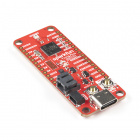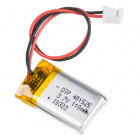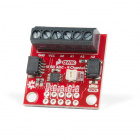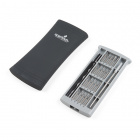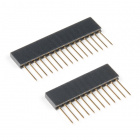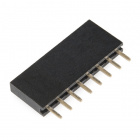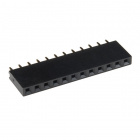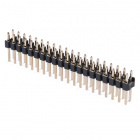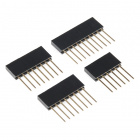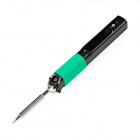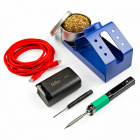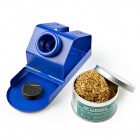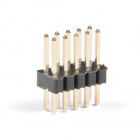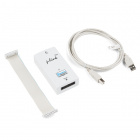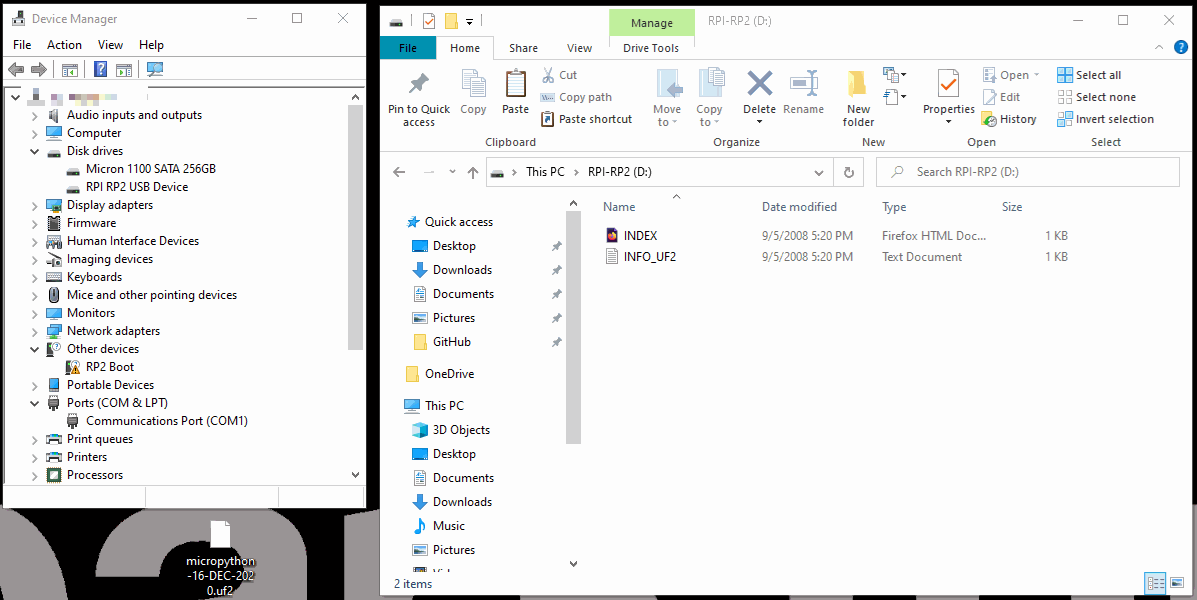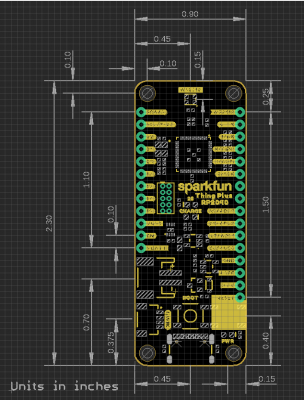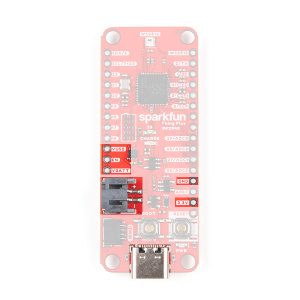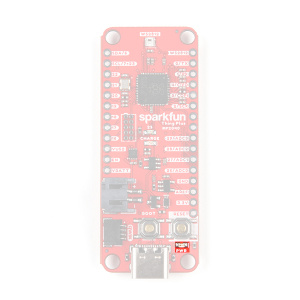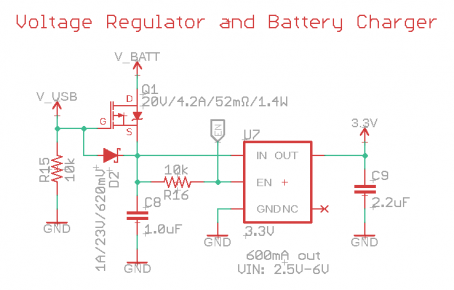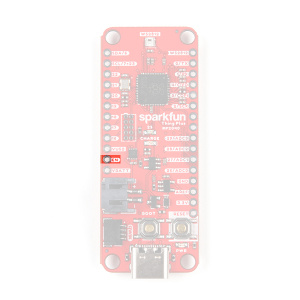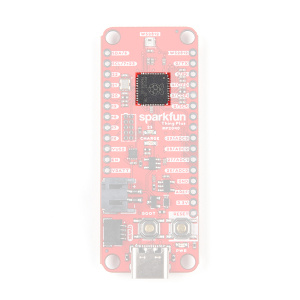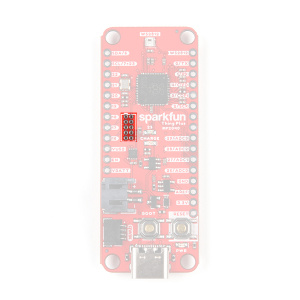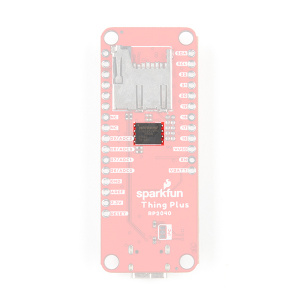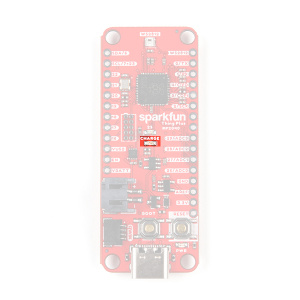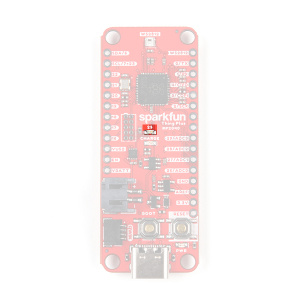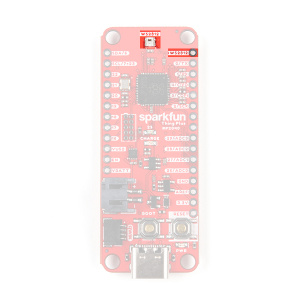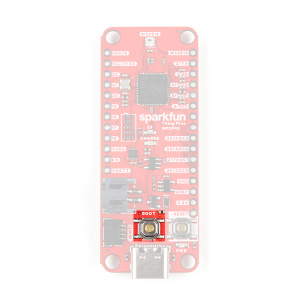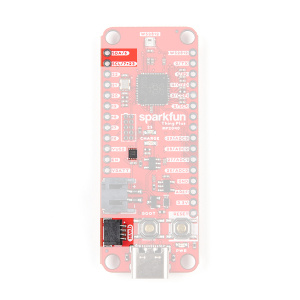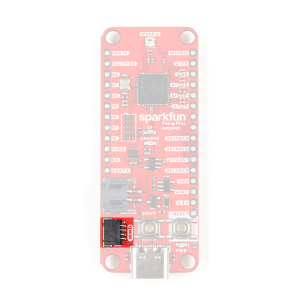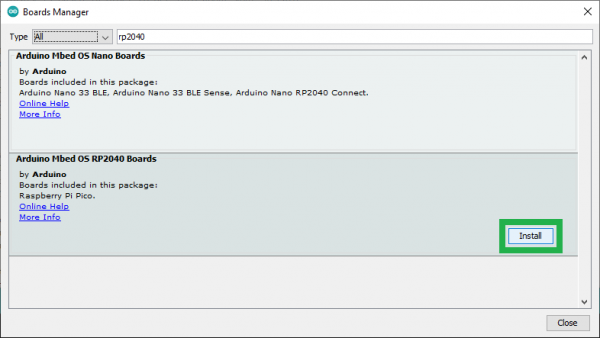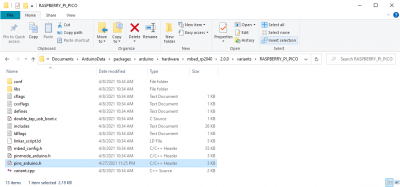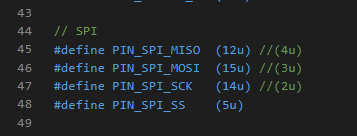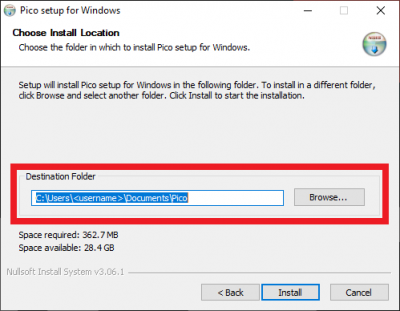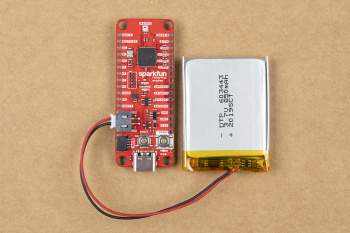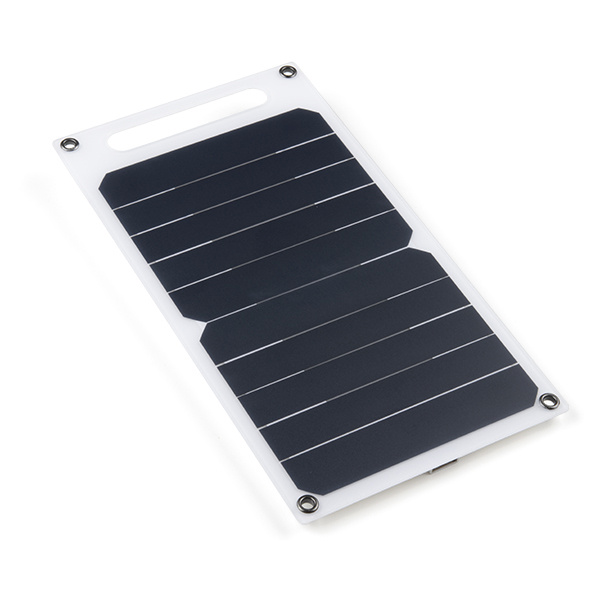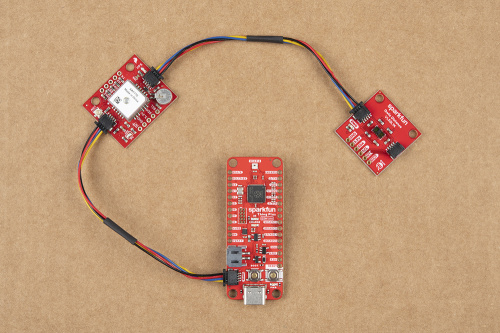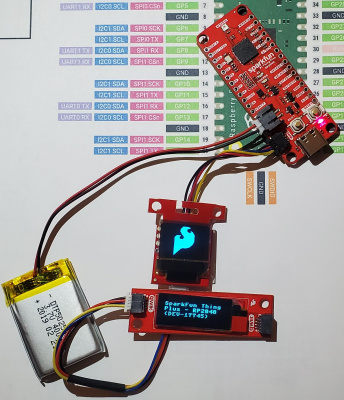RP2040 Thing Plus Hookup Guide
Introduction
Introducing the SparkFun Thing Plus - RP2040, featuring the RP2040 microcontroller (MCU) on a Feather (Thing Plus) form-factor. Additionally, this development platform also provides an SD card slot, 16MB (128Mbit) flash memory, a JST single cell battery connector (with a charging circuit and attached fuel gauge sensor), a WS2812 RGB LED, JTAG (PTH) pins, and our signature Qwiic connector.
The Raspberry Pi RP2040 (the first MCU from the Raspberry Pi Foundation) is a low cost, dual-core Arm® Cortex® M0+ microcontroller with 264kB of SRAM, running at 133MHz. It includes USB host functionality, a timer with 4 alarms, a real time counter (RTC), six dedicated IO pins for Quad-SPI flash (supporting execute in place), and thirty multifunction GPIO (*18 of which are broken out on the board), with the following capabilities:
- Four 12-bit Analogue to Digital Converter (ADC) channels
- Two UART buses
- Two I2C buses
- Two SPI buses
- Up to 16 PWM channels
- Can emulate interfaces such as SD Card and VGA
Required Materials
To get started, users will need a few items. Now some users may have a few of these items, feel free to modify your cart accordingly.
- SparkFun Thing Plus - RP2040
- USB 3.1 Cable A to C - 3 Foot - The USB interface serves two purposes: it powers the board and allows you to upload programs to it. (*If your computer doesn't provide a USB-A slot, then you will need to choose an appropriate cable or purchase an adapter as well.)
- Computer with an operating system (OS) that is compatible with all the software installation requirements:
- Windows 10
- Mac OSX
- Raspberry Pi OS
Batteries Jumper Modification Headers & Accessories
wish to perform. Feel free to modify the items in your cart to fit your needs.
Li-Po Battery
For mobile applications, users will want to pick up a single-cell LiPo battery from our catalog. Below, are a few available options:
Lithium Ion Battery - 1Ah
PRT-13813Jumper Modification
To modify the jumpers, users will need soldering equipment and/or a knife.
Weller WLC100 Soldering Station
TOL-14228Qwiic Example
If you would like to follow along with the examples below to interact with the physical world, you will also need the following items:
Qwiic Cable - 100mm
PRT-14427Magnetic Screwdriver Set (20 Piece)
TOL-15003Headers & Accessories
Headers are great for development purposes, letting users swap parts with just a set of jumper wires. If you would like to add headers to your board, check out some of the options for the Thing Plus or Feather form factor boards:
SparkFun Beginner Tool Kit
TOL-14681Below is a sample selection of our other headers and soldering tools in our catalog. For a full selection of our available Headers or Soldering Tools, click on the associated link.
JTAG Functionality
Users interested in JTAG applications (i.e. programming and debugging the RP2040) will need an Arm® Programmer and need to solder on a JTAG header. We recommend these programmers from our catalog:
J-Link EDU Mini Programmer
PGM-15345J-Link EDU Base Programmer
PGM-15346J-Link BASE Compact Programmer
PGM-15347Suggested Reading
Here are a few tutorials that may help users familiarize themselves with various aspects of the board.
How to Solder: Through-Hole Soldering
Serial Communication
Serial Peripheral Interface (SPI)
Battery Technologies
Pulse Width Modulation
Logic Levels
I2C
Analog vs. Digital
One of the new, convenient features of the board is that it takes advantage of the Qwiic connect system. We recommend familiarizing yourself with the Logic Levels and I2C tutorials. Click on the banner above to learn more about Qwiic products.
UF2 Bootloader
The SparkFun Thing Plus - RP2040 is easy to program, thanks the UF2 bootloader. With the UF2 bootloader, the RP2040 Thing Plus shows up on your computer as a USB storage device without having to install drivers for Windows 10, Mac, and Linux!
What is UF2?
UF2 stands for USB Flashing Format, which was developed by Microsoft for PXT (now known as MakeCode) for flashing microcontrollers over the Mass Storage Class (MSC), just like a removable flash drive. The file format is unique, so unfortunately, you cannot simply drag and drop any compiled binary or hex file onto the board. Instead, the format of the file must have specific information to tell the processor where the data goes, in addition to the data itself. For more information about UF2, you can read more from the MakeCode blog, as well as the UF2 file format specifiation.
BOOTSEL Mode
Users can enter BOOTSEL mode by holding down the BOOT button, when the USB connection is made to a computer. The board will remain in this mode until it power cycles (happens automatically after uploading a .uf2 firmware file) or the RESET button is pressed. The board will appear as a USB mass storage device under the name RPI-RP2.
BOOT button to enter BOOTSEL mode. Note: As another option, with the USB-C cable already connected to the board and the computer, users can hold down the BOOT button and toggle the RESET button to enter BOOTSEL mode. However, this method does require a little bit of finger dexterity.
Hardware Overview
Board Dimensions
The SparkFun RP2040 Thing Plus has a feather form factor and the board dimensions are illustrated in the drawing below.
Power
The SparkFun RP2040 Thing Plus only requires 3.3V to power the board. However, the simplest method to power the board is through the USB-C connector.
The power pins that are available on the board, are detailed below:
3V3- A regulated 3.3V voltage source (600mA).- Regulated from the USB 5V power and/or battery connection by a AP2112 LDO.
- Used to power the RP2040 MCU, WS2812 RGB LED, W25Q128 16MB flash chip, µSD card slot, and Qwiic I2C bus.
- Serves as the reference voltage for the RP2040 ADC (
ADC_VDD). - Pin can also operate as an input from an external power source.
USB- The voltage from the USB-C connector, usually 5V.- Used to provide a regulated 3.3V source through the AP2112 LDO (see above).
- Serves as the power supply for the MCP73831 linear charge management controller to the JST battery connector.
- Utilizes a P-channel MOSFET to control the power source for the AP2112 LDO.
- Utilizes a BAT20J protection diode for the USB-C connection.
VBAT- The voltage from the JST battery connector; meant for single cell LiPo batteries.- Used to provide a regulated 3.3V source through the AP2112 LDO (see above).
- Connected to the MCP73831 linear charge management controller.
GND- The common ground or the 0V reference for the voltage supplies.
Current Consumption
The Thing Plus - RP2040 consumes about 24mA on average, without any code running. The table below, summarizes the approximate current draw of the SparkFun RP2040 Thing Plus, through the USB-C connector, for various operational conditions.
| Operation | 1st Boot | BOOTSEL Mode |
Idle | Idle | MicroPython | |||
|---|---|---|---|---|---|---|---|---|
| Battery Charging |
GPIO 25LED ON |
WS2812 LED White (max) |
.uf2 Boot |
REPL Open | ||||
| Current Draw (mA) |
11 (Idle) 20 (Peak) |
11-14 | -- | -- | 25 | 40-42 | 22-24 | 23-24 |
Note: The RP2040 microcontroller has two low power states:
SLEEP- All the processors are asleep and most of the clocks in the chip are stoppedDORMANT- All clocks in the chip are stopped
Power Status LED
The red, POWER LED will light up once 3.3V is supplied to the board; however, for most users, it will light up when 5V is supplied through the USB connection or when a LiPo battery is connected to the JST connector.
POWER status LED indicator. (Click to enlarge) Charging Circuit
The charging circuit utilizes the MCP73831 linear charge management controller and is powered directly from the USB-C connector or USB. The controller is configured for a 500mA charge rate and battery charging is indicated by the yellow, CHG LED. If the charge controller is shutdown or charging is complete, the CHG LED will turn off. For more information, pleas refer to the MCP73831 datasheet.
Power Control
The power source to the AP2112 LDO voltage regulator is controlled by a P-channel MOSFET. In addition, the 3.3V regulated output from the AP2112 is controlled by the enable (EN) pin, broken out on the board.
The P-channel MOSFET operation is based on the voltages at the MOSFET's gate and source pins. Depending on the power sources connected to the board, the MOSFET will act as a switch and control power from the battery to the AP2112 voltage regulator; detailed in the following table.
| Power Source | MOSFET | Power Control Description | |||
|---|---|---|---|---|---|
| Gate | Source |
VGS (VGate - VSource) |
MOSFET Operation |
||
| USB Only | VUSB = 5V | VUSB - Vf |
VUSB - (VUSB - Vf) VGS = Vf |
MOSFET Off RGS = ∞ Switch Open |
Power to the AP2112 is supplied by the USC-C connection. Power from the USB-C connection is passed through the Schottky diode. Due to the voltage drop from the Schottky diode, the gate threshold voltage for the MOSFET is positive and equivalent to the diode's forward voltage (Vf).Therefore, the MOSFET behaves as an open switch. |
| Battery Only | VUSB = 0V |
Dep. Mode: VSource = 0 Charged Cap.: VBatt = 3 - 4.2V |
Dep. Mode: VGS = 0 Charged Cap.: VUSB - VBatt = -VBatt -3V > VGS > -4.2V |
MOSFET On RGS = Low Switch Closed |
Power to the AP2112 is supplied from the battery connection. As a depletion type P-channel MOSFET, the mosfet acts as a normally closed switch when the gate threshold voltage is zero. Therefore, power from the battery is able to charge the capacitor and create a negative gate threshold voltage. The MOSFET remains behaving as a closed switch and power to the AP2112 is provided from the battery. |
| USB & Battery | VUSB = 5V | VUSB - Vf | VGS = Vf |
MOSFET Off RGS = ∞ Switch Open |
Power to the AP2112 is supplied by the USC-C connection. Power from the USB-C connection is passed through the Schottky diode. Due to the voltage drop from the Schottky diode, the gate threshold voltage for the MOSFET is positive and equivalent to the diode's forward voltage (Vf).Therefore, the MOSFET behaves as an open switch. |
The enable pin of the AP2112 LDO also provides an additional amount of control for power to the board. By default, the chip enable pin (EN) is pulled high, to enable the 3.3V output, supply voltage. To disable and shutdown the output voltage from the AP2112, the chip enable pin (EN) needs to be pulled low (i.e. shorted to ground (GND)). For more information, pleas refer to the AP2112 datasheet.
Protection
A BAT20J Schottky diode, in the power circuit, provides reverse current protection to the USB-C (VUSB) connector, from the battery (VBAT) or the board.
RP2040 Microcontroller
The Raspberry Pi RP2040 is a low-cost, high-performance microcontroller with flexible digital interfaces. It features:
- Dual Arm® Cortex®-M0+ processors, up to 133 MHz
- 264 kB of embedded SRAM in 6 banks
- 6 dedicated IO for additional storage
- Connects to QSPI Flash
- Supports execute in place (XIP))
- 30x 3.3V user-programmable high-speed IO (only 18 are broken out on the board)
- 4x 12-bit 500ksps Analogue to Digital Converter (ADC)
- Various digital peripherals
- 2x UART, 2x I2C, 2x SPI, up to 16 PWM channels
- 1x Timer with 4 alarms, 1x Real Time Counter
- USB 1.1 Host/Device compatible
The processor implements the ARMv6-M Thumb instruction set and provides programmable (multifunction) IO (PIO), which is unique to the RP2040. For more information, pleas refer to the RP2040 datasheet.
JTAG Pins
For users interested in debugging their code, the SWD pins are broken out on JTAG PTH pins. On the RP2040, the debug pins are:
- Pin 24:
SWCLK - Pin 25:
SWDIO
An individual debug access port (DAP) to each core is attached to a shared multidrop SWD bus. Each DAP will
only respond to debug commands if correctly addressed by a SWD TARGETSEL command. In the event that the RP2040 locks up, a Rescue debug port is available to reset the microcontroller. The default address of each debug port is listed below:
- Core 0:
0x01002927 - Core 1:
0x11002927 - Rescue DP:
0xf1002927
PSM_RESTART_FLAG of the CHIP_RESET register and resets the RP2040. On startup, the CHIP_RESET register is read by the bootcode and when set, it causes the RP2040 to enter a safe state.USB Functionality
The RP2040 contains a USB 2.0 controller that can operate as either:
- Full Speed device (12 Mbit/s)
- Host that can communicate with both Low Speed (1.5 Mbit/s) and Full Speed devices. This includes multiple downstream devices connected to a USB hub.
USB Mass Storage Interface
The Bootrom provides a standard USB bootloader that emulates a writeable drive available for loading firmware to the RP2040
using UF2 files. Once a UF2 file is loaded onto the drive, it is written to the flash or RAM and the device automatically reboots.
- The bootrom source code is hosted on GitHub.
RPI-RP2 Drive
The RP2040 appears as a standard 128MB flash drive named RPI-RP2 formatted as a single partition with FAT16. There
are only ever two actual files visible on the drive specified.
INFO_UF2.TXT- contains a string description of the UF2 bootloader and version.INDEX.HTM- redirects to information about the RP2040 device.
.uf2 file is written to the device however, the special contents are recognized and data is written to specified locations in RAM or Flash. On the completed download of an entire valid .uf2 file, the RP2040 automatically reboots to run the newly downloaded code.Flash Memory
RP2040 has embedded ROM and SRAM, and access to external flash via a QSPI interface. On the SparkFun RP2040 Thing Plus, an additional 16MB (128Mbit) of 133MHz memory is provided by a W25Q128JVPIM chip. The flash memory is required for the RP2040 to store program code, which it can boot and run from through its dedicated QSPI pins:
- Pin 52:
CLK - Pin 56:
CS - Pin 53:
DATA 0/DI - Pin 55:
DATA 1/DO - Pin 54:
DATA 2/WP - Pin 51:
DATA 3/HOLD
0x10000000.Indicator LEDs
There are 4 indication LEDs on the SparkFun RP2040 Thing Plus for:
PWR: Power (Red)CHG: Battery Charging (Yellow)25:GPIO 25(Blue)WS2812:GPIO 08(RGB)
Power LED
The red, PWR LED will light up once 3.3V is supplied to the board. For most users, it will light up when 5V is supplied through the USB connection and/or when a LiPo battery is attached to the JST connector.
PWR status LED indicator. (Click to enlarge) Battery Charging LED
The yellow, CHG LED will light while a battery is being charged through the charging circuit. The LED will be off when no battery is present (*or dimmed), when the charge management controller is in standby (after the battery charging has been completed), or when the charge management controller is shutdown (thermal shutdown or when the input voltage is lower than the battery voltage). The LED will be on when the charge management controller is in the process of charging the battery. For more information, please refer to the MCP73831 datasheet.
| Charge Cycle State | STAT1 |
|---|---|
Shutdown
|
Off (High Z) |
| No Battery Present* | Dimmed (High Z) |
| Charge Complete – Standby | Off (H) |
| Preconditioning | On (L) |
| Constant-Current Fast Charge | On (L) |
| Constant Voltage | On (L) |
*The charge LED may appear dimmed due a trickle charge from the MAX17048 fuel gauge. Normally, the LED should be OFF.
Status LED
The blue, 25 LED is typically used as a test or status LED to make sure that a board is working or for basic debugging. This indicator is connected to GPIO 25.
25) LED indicator on the SparkFun RP2040 Thing Plus. (Click to enlarge) WS2812 RGB LED
The WS2812 RGB LED is controlled with a 24-bit (GRB) data signal. This indicator is connected to GPIO 08 and the digital output pin from the LED is broken out as the WS2812 pin on the board. For more information, please refer to the WS2812C datasheet.
WS2812 LED indicator on the SparkFun RP2040 Thing Plus. (Click to enlarge) µSD Slot
MOSI signal on a controller has been replaced with the title SDO. Please refer to this announcement on the decision to deprecate the MOSI/MISO terminology and transition to the SDO/SDI naming convention.
The SparkFun RP2040 Thing Plus includes an µSD card slot. This is great for data logging applications or storing files. The µSD card slot is connected to the following dedicated GPIO:
GPIO 09:DATA 3/CSGPIO 10:DATA 2GPIO 11:DATA 1GPIO 12:DATA 0/CIPO(or Peripheral'sSDO)GPIO 14:CLK/SCKGPIO 15:CMD/COPI(or Peripheral'sSDI)
Buttons
The Thing Plus -RP2040 has two buttons on the board for uploading and running code.
Reset Button
The RESET button is connected to the reset pin and is used to reset the microcontroller without needing to unplug the board.
RESET button on the SparkFun RP2040 Thing Plus. (Click to enlarge) Boot Button
The BOOT button is used to force the board into BOOTSEL mode, by holding down the BOOT button while connecting the board to a computer through its USB-C connector. Users can then, upload firmware files to the emulated RPI-RP2 USB mass storage device.
BOOT button on the SparkFun RP2040 Thing Plus. (Click to enlarge) BOOTSEL Mode: Users can enter BOOTSEL mode by holding down the BOOT button, when the USB connection is made to a computer. The board will remain in this mode until it power cycles (happens automatically after uploading a .uf2 firmware file) or the RESET button is pressed. The board will appear as a USB mass storage device under the name RPI-RP2.

Hold down
BOOT button to enter BOOTSEL mode on The SparkFun Thing Plus - RP2040. (Click to enlarge)
Primary I2C Bus
A (battery) fuel gauge and a Qwiic connector are attached to the primary I2C bus I2C1. The primary I2C bus for this board utilizes the GPIO connections, detailed in the table below:
| Connection | VDD |
GND |
SCL |
SDA |
|---|---|---|---|---|
| Pin Number | 3.3V | GND |
Pin 9 Pin 35 |
Pin 8 |
| GPIO | 3.3V | GND |
GPIO 07GPIO 23
|
GPIO 06 |
Note: The clock line of the I2C bus is tied between pins 9 and 35 (GPIO 07 and GPIO 23). This allows GPIO 16 - GPIO 23 to be aligned on the board's edge, for a consecutive, eight pin bus; useful for things like HDMI.

Shared pin for
GPIO 07 and GPIO 23 on the SparkFun RP2040 Thing Plus. (Click to enlarge)
*Since the two GPIO pins are tied together, they cannot operate simultaneously.
Battery Fuel Gauge
The MAX17048 fuel gauge measures the approximate charge or discharge rate, state of charge (SOC) (based on ModelGauge algorithm), and voltage of a connected battery. Additionally, there is a configurable alert pin functionality for low SOC, 1% SOC, reset, overvoltage, or undervoltage. For more information, pleas refer to the MAX17048 datasheet.
| I2C Address |
0x36 (7-bit) 0x6C (write)/0x6D (read) |
| Voltage Measurement |
Range: 2.5 - 5 V Precision: ±7.5 mV/Cell Resolution 1.25 mV/Cell |
| Current Consumption |
Sleep: .5 - 2 µA Hibernate: 3 - 5 µA Active: 23 - 40 µA |
| Alert Indicators: |
Low SOC 1% Change in SOC Battery Undervoltage/Overvoltage VRESET Alert |
| Alert Pin | GPIO 24 |
Qwiic Connector
A Qwiic connector is provided for users to seamlessly integrate with SparkFun's Qwiic Ecosystem.
What is Qwiic?
The Qwiic system is intended a quick, hassle-free cabling/connector system for I2C devices. Qwiic is actually a play on words between "quick" and I2C or "iic".
Features of the Qwiic System
Keep your soldering iron at bay.
Cables plug easily between boards making quick work of setting up a new prototype. We currently offer three different lengths of Qwiic cables as well as a breadboard friendly cable to connect any Qwiic enabled board to anything else. Initially you may need to solder headers onto the shield to connect your platform to the Qwiic system but once that’s done it’s plug and go!
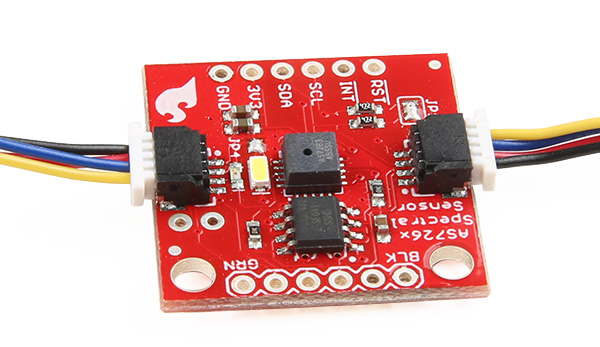
Qwiic cables connected to Spectral Sensor Breakout
Minimize your mistakes.
How many times have you swapped the SDA and SCL wires on your breadboard hoping the sensor will start working? The Qwiic connector is polarized so you know you’ll have it wired correctly, every time, from the start.
The PCB connector is part number SM04B-SRSS (Datasheet) or equivalent. The mating connector used on cables is part number SHR04V-S-B or equivalent. This is a common and low cost connector.
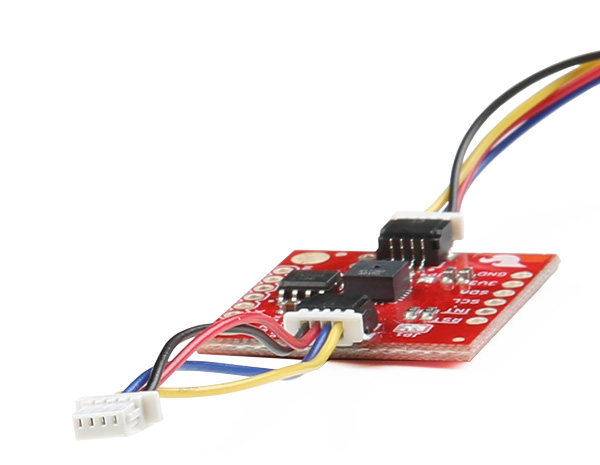
1mm pitch, 4-pin JST connector
Expand with ease.
It’s time to leverage the power of the I2C bus! Most Qwiic boards will have two or more connectors on them allowing multiple devices to be connected.
I2C Jumper
Cutting the I2C jumper will remove the 4.7kΩ pull-up resistors from the I2C bus. If you have many devices on your I2C bus you may want to remove these jumpers.
Software Overview
The Raspberry Pi foundation provides excellent documentation for the RP2040 on their website. This includes information for users to program the RP204 with MicroPython and C/C++ through the Pico SDK. Arduino, has also announced the release of their Mbed RP2040 Arduino core. The instructions below, are meant to help users setup and utilize the following programming environments on Windows 10 computers:
- Arduino IDE
- Pico SDK (C/C++)
- MicroPython
- REPL
rshell
For utilizing the Pico SDK (C/C++) and MicroPython on Mac OSX and Linux based computers, users can follow the instructions provided by the Raspberry Pi Foundation documentation:
- Getting Started with Raspberry Pi Pico (PDF)
- Raspberry Pi Pico C/C++ SDK User Manual (PDF)
- Raspberry Pi Pico Python SDK User Manual (PDF)
Arduino IDE
Most users will be familiar with the Arduino IDE and it's use. As a point of reference for professional developers who aren't aware, the Arduino IDE is an open-source development environment, written in Java, that makes it easy to write code and upload it to a supported board. For more details, feel free to check out the Arduino website.
To get started with the Arduino IDE, check out the following tutorials:
Installing an Arduino Library
What is an Arduino?
Installing Arduino IDE
Installing Board Definitions in the Arduino IDE
Installing the RP2040 Board Definition
Install the latest Arduino Mbed OS RP2040 board definitions in the Arduino IDE. Users unfamiliar with the board definition installation process can reference our tutorial below.
Installing Board Definitions in the Arduino IDE
Installation Instructions:
- Search for
RP2040in the Boards Manager.
Arduino Mbed OS RP2040 listed in the Boards Manager. (Click to enlarge) - To complete the installation process, selected the Arduino Mbed OS RP2040 core and click on the INSTALL button that appears in the lower, right-hand corner. The board definition and upload tools will be installed automatically; users will notice that this may take a while.
Note: Users may need to disable their anti-virus software when installing the Arduino Mbed OS RP2040 board definition. We ran into issues, where the installation of the upload tools for the Arduino core were blocked by the anti-virus software. Arduino is already aware of the issue, they are working to get their files white-listed. For more information, users can reference this GitHub issue. Programming Tip:
The board may not show up on a COM port, if users who have already programmed their board through a different method. A simple solution is to:
- Download the
picoprobe.uf2file from the Raspberry Pi foundation's Pico board documentation page - Copy the
picoprobe.uf2firmware file to the board (while it is inBOOTSELmode) - If the board isn't automatically listed on a COM port users should reset (or unplug and re-plug in the board to the computer)
Note: If users have the Arduino IDE's Tools drop down menu open looking for a new COM port to be added, the Arduino IDE doesn't automatically repopulate and update the listed COM ports. To update the available COM ports list, users should close and then re-open the Tools drop down menu and navigate to the available COM ports.- Download the
Note: Users trying to access the SD card slot will need to modify the pins_arduino.h file to reconfigure the SPI bus pins. However, this will make the SPI bus inaccessible through the breakout pins (when utilizing the SPI library).
On a Windows 10 computer, with the Arduino IDE installed through the App store, the location of the
pins_arduino.hfile is:C:\Users\<username>\Documents\ArduinoData\packages\arduino\hardware\mbed_rp2040\<package_version>\variants\RASPBERRY_PI_PICO
pins_arduino.hfile in theRASPBERRY_PI_PICOfolder. (Click to enlarge)Users will need to modify lines 45 - 47 of the
pins_arduino.hfile to the following:// SPI #define PIN_SPI_MISO (12u) //(4u) #define PIN_SPI_MOSI (15u) //(3u) #define PIN_SPI_SCK (14u) //(2u)
Line modifications to thepins_arduino.hfile. (Click to enlarge)
earlephilhower has ported an unofficial Arduino core for the RP2040, which is based on the Pico SDK. This is useful for customers who want the functionality of the Pico SDK in the Arduino IDE. Installation instructions are available in the GitHub repository.
Pico SDK
In order to program the RP2040 with C/C++, users will use the Pico SDK (software development kit) provided by the Raspberry Pi Foundation. Additionally, the Raspberry Pi Foundation has written a user manual, which includes software documentation and examples to accompany the Pico SDK. The foundation has also provided online documentation that can be used as a reference manual.
Getting Started: For novice programmers, we recommend starting off with the Getting Started with Raspberry Pi Pico guide, from the Raspberry Pi Foundation. While the guide is intended for their RP2040 microcontroller board, it contains useful information for getting started with the Pico SDK, building and uploading a program, debugging, and adapting the SDK to a third-party IDE.
Installation: The Raspberry Pi Foundation also provides an installation script to download and setup the Pico SDK on a Raspberry Pi (SBC) single board computer, which can be downloaded from their GitHub repository.
.uf2 file, which the SDK generates. The .uf2 firmware file is then copied to the board, when it is in BOOTSEL mode to upload the program.
As documented in the user manual, the Pico C/C++ SDK can be used with various integrated development environments (IDEs). In order to utilize the SDK, users will also need to install a few dependencies. The Raspberry Pi Foundation also provides examples for the basic functionality of the RP2040 in their pico-examples GitHub repository.
Pico SDK on Windows 10
Note: The information for below has been compiled based on the information from the following resources:
On Windows 10 computers, the simplest way to get started with the Pico SDK is to use the installation script from the pico-setup-windows GitHub repository.
Users will need to download and use the installation executable files from the releases section:
- For 32-bit systems, users will want to use the executable ending in
x86.exe - For 64-bit systems, users will want to use the executable ending in
x64.exe
Installation Instructions:
- Use the setup script from the
pico-setup-windowsGitHub repo- Download release executable for your system architecture:
- Run the downloaded executable
- Utilize the default configurations
- Feel free to customize the installation for your computer system
- Note the file path to the installed
PicofolderInstallation file path. (Click to enlarge)
- Un-select the
Clone and build Pico repocompletion option before clicking Finish button- By selecting this option, the executable will automatically build the Pico SDK for the Raspberry Pi Pico board and not the RP2040 Thing Plus.
- Additionally, users who haven't configured their computer system's
PATHvariable for the installed dependencies will run into various errors.Installation completion options. (Click to enlarge)
Configure the computer system's
PATHvariables for the installed dependencies:User Variables:
Variable Value PICO_SDK_PATHC:\<path to installed Pico folder>\pico-sdk
Note: Users will need to modify this variable if thePicofolder is moved.PathC:\Users\<username>\AppData\Local\Programs\Microsoft VS Code\binSystem Variables:
Variable Value PathC:\Program Files\CMake\binPathC:\Program Files (x86)\GNU Arm Embedded Toolchain\10 2020-q4-major\bin
Note: The release value10 2020-q4-majorwill likely change over time.PathC:\Program Files\Git\cmdPathC:\Program Files (x86)\GnuWin32\binPathC:\Users\<username>\AppData\Local\Programs\Microsoft VS Code\binPathC:\Program Files (x86)\Microsoft Visual Studio\2019\BuildTools\VC\Tools\MSVC\14.28.29910\bin\Hostx86\x86
Note: The version/release values2019and14.28.29910will likely change over time.PathC:\Program Files\<PythonXx>\
Note: The version/release value for the Python program will likely change over time.
Note: The file path may also vary. For the Python 3.6, our file path was:
C:\Users\<username>\AppData\Local\Programs\Python\Python36-32\PathC:\Program Files\<PythonXx>\Scripts\
Note: The version/release value for the Python program will likely change over time.
Note: The file path may also vary. For the Python 3.6, our file path was:
C:\Users\<username>\AppData\Local\Programs\Python\Python36-32\Scripts\For more information on configuring the PATH variable, check out the tutorial below:
Configuring the PATH System Variable
A simple guide for configuring the PATH variable on Win 10, Mac OSX, and Linux systems.
Build Instructions:
Executing the pico-setup.cmd script will download all the relevant RP2040 GitHub repositories, update all the submodules, and build the examples for the Pico SDK. (Users will need to modify the pico-setup.cmd script to build the examples for the RP2040 Thing Plus and not the Raspberry Pi Pico board.)
- Navigate to the installation location of the
Picofolder - Modify the
pico-setup.cmdscript on line 62, replacecmake -G "NMake Makefiles" ..with:cmake -G "NMake Makefiles" .. -DPICO_BOARD=sparkfun_thingpluscmake -G "NMake Makefiles".. -DCMAKE_BUILD_TYPE=Debug -DPICO_BOARD=sparkfun_thingplus(for debugging)Modification for the Pico SDK build configuration. (Click to enlarge)
- Execute
pico-setup.cmd- If users run into errors, they may need to call
pico-env.cmdfrom the terminal/command prompt and then callpico-setup.cmd
- If users run into errors, they may need to call
- Users will find the builds for the example code in the
pico-examples\buildfolder. In each of the built example folders, users will find the.uf2file associated with the individual example. - Once the board is in
BOOTSELmode, user can copy the.uf2file over to program their board.
MicroPython
The Raspberry Pi Foundation has provided support for the RP2040 microcontroller with MicroPython. Additionally, the Raspberry Pi Foundation has written a user manual, which includes documentation and some basic MicroPython examples.
Getting Started: For novice programmers, we recommend starting off with the Get Started with MicroPython on Raspberry Pi Pico book, writtten by the Raspberry Pi Foundation. While the book is intended for their Raspberry Pi Pico board, it contains useful information for getting started with MircoPython, utilizing the REPL (Read–Eval–Print Loop), and several projects.
Note: Users will only need to download MicroPython, if they want to rebuild the .uf2 file or inlude a Python package in their custom build. For more information on MicroPython check out their online documentation and the README.md for the RP2040 port.
Basic Operation: Before users can begin programming with MicroPython, they will need to copy the .uf2 firmware file to the board (while it is in BOOTSEL mode). The latest MicroPython firmware can be downloaded from the RP2040 documentation on the Raspberry Pi Foundation website.
*.uf2 firmware file can be download from the MicroPython website.
Once copied, the RP2040 should automatically reset. Then users can utilize the REPL (Read–Eval–Print Loop) to interface with the microcontroller directly or use rshell to upload and save their code to the flash memory of the RP2040.
As documented in the user manual, the MicroPython can be used with various integrated development environments (IDEs). In order to utilize the SDK, users will also need to install a few dependencies. The Raspberry Pi Foundation also provides MicroPython examples to accompany the book (noted above), which can be downloaded from their GitHub repository.
Read–Eval–Print Loop (REPL)
Note: The RP2040 Thing Plus must be running MicroPython to access and utilize the REPL.
- Users need to copy the
.uf2MicroPython firmware file to the board (while it is inBOOTSELmode). - The latest MicroPython firmware can be downloaded from from the RP2040 documentation on the Raspberry Pi Foundation website.
Users can access the REPL with their favorite serial terminal to instantly program the RP2040 microcontroller. After the MicroPython firmware is copied to the board, it will reset and show up on the computer's serial (or COM) port. Make sure to configure the serial terminal emulator for a baudrate of 115200 bps.
Remote MicroPython Shell on Windows 10
Note: The RP2040 Thing Plus must be running MicroPython to utilize rshell and upload your program.
- Users need to copy the
.uf2MicroPython firmware file to the board (while it is inBOOTSELmode). - The latest MicroPython firmware can be downloaded from from the RP2040 documentation on the Raspberry Pi Foundation website.
- If users upload another
.uf2file on to the board, the RP2040 will execute the new code. However, any saved Python files may still remain in flash (instead of getting overwritten by the new code). Therefore, when users upload the.uf2MicroPython firmware file back onto the board, the previously saved python files may:- Execute on reboot
- Run on a soft-reboot in the REPL
Installation Instructions:
- Install prerequisites
- Install Remote MicroPython Shell (
rshell)- In PowerShell (run as admin), type
pip3 install rshell
- In PowerShell (run as admin), type
Programming Instructions:
Below is an example of how to upload a program to the board using rshell on Windows 10.
- Change the working directory to the location of the program file
- Open
rshell- In PowerShell or the Command Prompt (run as admin), type
rshell
- In PowerShell or the Command Prompt (run as admin), type
- In the remote shell, connect to the COM port for the RP2040 Thing Plus
- Type
connect serial COM[#] [baudrate]- To connect to
COM3:connect serial COM3 115200 - *Use the device manager to find the COM port for the RP2040 Thing Plus
- To connect to
- Type
- In the remote shell, copy your program file to the RP2040 Thing Plus
- Type
cp [file name] /[board name]- By default MicroPython executes two files on restart or power up:
boot.py– this script is executed when the pyboard boots up. It sets up various configuration options for the pyboardmain.py– this is the main script that will contain your Python program. It is executed afterboot.py
- By default
rshellwill name a boardpyboardwhen connecting to the COM port (unless otherwise specified)- *The command
boards, inrshell, will list the boards that it is connected to, their names, and the connection
- *The command
- By default MicroPython executes two files on restart or power up:
- Type
- Once the user presses the
RESETbutton, the board will disconnect fromrshelland the RP2040 microcontroller will execute theboot.pyandmain.pyfiles stored in its flash.
rshell. (Click to enlarge) Hardware Assembly
USB Programming
The USB connection is utilized for programming and serial communication. Users only need to plug their RP2040 Thing Plus into a computer using a USB-C cable.
BOOTSEL Mode
Users can enter BOOTSEL mode by holding down the BOOT button, when the USB connection is made to a computer. The board will remain in this mode until it power cycles (happens automatically after uploading a .uf2 firmware file) or the RESET button is pressed. The board will appear as a USB mass storage device under the name RPI-RP2.
BOOT button to enter BOOTSEL mode on The SparkFun Thing Plus - RP2040. (Click to enlarge) Battery
For remote applications, the RP2040 Thing Plus can be powered through its 2-pin JST battery connector. Additionally, users may be interested in utilizing a solar panel and USB-C cable to recharge their battery.
Note: DO NOT remove batteries by pulling on their wires. Instead, it is recommended that pair of dikes (i.e. diagonal wire cutters), pliers, or tweezers be used to pull on the JST connector housing, to avoid damaging the battery wiring.
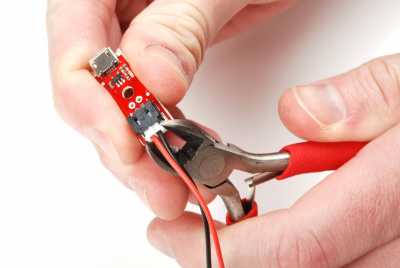
Using a pair of dikes to disconnect a battery. (Click to enlarge)
Headers
The pins for the RP2040 Thing Plus are broken out to 0.1"-spaced pins on the outer edges of the board. When selecting headers, be sure you are aware of the functionality you need. If you have never soldered before or need a quick refresher, check out our How to Solder: Through-Hole Soldering guide.
The Feather Stackable Header Kit is a great option as it allows users to stack shields (w/ Feather footprint) or it can be placed on the a breadboard; while, the pins are still accessible from the female/male headers.
Qwiic Devices
The Qwiic system allows users to effortlessly prototype with a Qwiic compatible I2C device without soldering. Users can attach any Qwiic compatible sensor or board, with just a Qwiic cable. (*The example below, is for demonstration purposes and is not pertinent to the board functionality or this tutorial.)
MicroPython Examples
Below, are some MicroPython examples that can be copied and pasted into the REPL.
LED Control
This example turns on the GPIO 25 status LED. Try changing the led.value() value to 0.
language:python
from machine import Pin
led = Pin(25, Pin.OUT)
led.value(1)
# Include blank carriage returns
WS2812 Control
This example controls the WS2812 RGB LED on the board. Try changing the r, g, and b values (range is 0 - 255).
language:python
# Example using PIO to drive a WS2812 LED
// Copy and paste directly into REPL from TeraTerm
// Make sure baudrate is set to 115200 bps
import array, time
from machine import Pin
import rp2
# Configure the number of WS2812 LEDs.
NUM_LEDS = 1
@rp2.asm_pio(sideset_init=rp2.PIO.OUT_LOW, out_shiftdir=rp2.PIO.SHIFT_LEFT, autopull=True, pull_thresh=24)
def ws2812():
T1 = 2
T2 = 5
T3 = 3
wrap_target()
label("bitloop")
out(x, 1) .side(0) [T3 - 1]
jmp(not_x, "do_zero") .side(1) [T1 - 1]
jmp("bitloop") .side(1) [T2 - 1]
label("do_zero")
nop() .side(0) [T2 - 1]
wrap()
# Create the StateMachine with the ws2812 program, outputting on Pin(08).
sm = rp2.StateMachine(0, ws2812, freq=8_000_000, sideset_base=Pin(08))
# Start the StateMachine, it will wait for data on its FIFO.
sm.active(1)
# Display a pattern on the LEDs via an array of LED RGB values.
ar = array.array("I", [0 for _ in range(NUM_LEDS)])
# Cycle colours.
for i in range(4 * NUM_LEDS):
for j in range(NUM_LEDS):
r = 255
b = 255
g = 255
ar[j] = g << 16 | r << 8 | b
sm.put(ar, 8)
# Include blank carriage returns
OLED Displays
This example displays a bitmap and text on two OLED screens. For this example, users will need the Micro OLED Breakout (Qwiic), the Qwiic OLED Display, and a Qwiic cable kit. Users will need to upload a modified version of the MicroPython firmware, which includes the SSD1306 display driver.
language:python
# Display Image & text on I2C driven ssd1306 OLED display
from machine import Pin, I2C
from ssd1306 import SSD1306_I2C
import framebuf
WIDTH_1 = 64 # oled display width
HEIGHT_1 = 48 # oled display height
WIDTH_2 = 128 # oled display width
HEIGHT_2 = 32 # oled display height
i2c = I2C(1) # Init I2C using I2C0 defaults, SCL=Pin(GP9), SDA=Pin(GP8), freq=400000
print("I2C Address : "+hex(i2c.scan()[0]).upper()) # Display device address
print("I2C Configuration: "+str(i2c)) # Display I2C config
oled1 = SSD1306_I2C(WIDTH_1, HEIGHT_1, i2c, addr=0x3D) # Init oled_1 display
# SparkFun logo as 32x48 bytearray
buffer[:] = [\
0x00, 0x00, 0x00, 0x00, 0x00, 0x00, 0x00, 0x00, 0x00, 0x00, 0x00, 0x00, 0x00, 0x00, 0x00, 0x00, \
0x00, 0x00, 0x00, 0x00, 0x00, 0x00, 0x00, 0x00, 0xE0, 0xF8, 0xFC, 0xFE, 0xFF, 0xFF, 0xFF, 0xFF, \
0xFF, 0xFF, 0xFF, 0x0F, 0x07, 0x07, 0x06, 0x06, 0x00, 0x80, 0x80, 0x00, 0x00, 0x00, 0x00, 0x00, \
0x00, 0x00, 0x00, 0x00, 0x00, 0x00, 0x00, 0x00, 0x00, 0x00, 0x00, 0x00, 0x00, 0x00, 0x00, 0x00, \
0x00, 0x00, 0x00, 0x00, 0x00, 0x00, 0x00, 0x00, 0x00, 0x00, 0x00, 0x00, 0x00, 0x00, 0x00, 0x00, \
0x00, 0x00, 0x80, 0x80, 0x80, 0x80, 0x80, 0x80, 0x81, 0x07, 0x0F, 0x3F, 0x3F, 0xFF, 0xFF, 0xFF, \
0xFF, 0xFF, 0xFF, 0xFF, 0xFE, 0xFE, 0xFC, 0xFC, 0xFC, 0xFE, 0xFF, 0xFF, 0xFF, 0xFC, 0xF8, 0xE0, \
0x00, 0x00, 0x00, 0x00, 0x00, 0x00, 0x00, 0x00, 0x00, 0x00, 0x00, 0x00, 0x00, 0x00, 0x00, 0x00, \
0x00, 0x00, 0x00, 0x00, 0x00, 0x00, 0x00, 0x00, 0x00, 0x00, 0x00, 0x00, 0x00, 0x00, 0x00, 0xFC, \
0xFE, 0xFF, 0xFF, 0xFF, 0xFF, 0xFF, 0xFF, 0xF1, 0xE0, 0xE0, 0xE0, 0xE0, 0xE0, 0xF0, 0xFD, 0xFF, \
0xFF, 0xFF, 0xFF, 0xFF, 0xFF, 0xFF, 0xFF, 0xFF, 0xFF, 0xFF, 0xFF, 0xFF, 0xFF, 0xFF, 0xFF, 0xFF, \
0x00, 0x00, 0x00, 0x00, 0x00, 0x00, 0x00, 0x00, 0x00, 0x00, 0x00, 0x00, 0x00, 0x00, 0x00, 0x00, \
0x00, 0x00, 0x00, 0x00, 0x00, 0x00, 0x00, 0x00, 0x00, 0x00, 0x00, 0x00, 0x00, 0x00, 0x00, 0xFF, \
0xFF, 0xFF, 0xFF, 0xFF, 0xFF, 0xFF, 0xFF, 0xFF, 0xFF, 0xFF, 0xFF, 0xFF, 0xFF, 0xFF, 0xFF, 0xFF, \
0xFF, 0xFF, 0xFF, 0xFF, 0xFF, 0xFF, 0xFF, 0xFF, 0xFF, 0xFF, 0xFF, 0x7F, 0x3F, 0x1F, 0x07, 0x01, \
0x00, 0x00, 0x00, 0x00, 0x00, 0x00, 0x00, 0x00, 0x00, 0x00, 0x00, 0x00, 0x00, 0x00, 0x00, 0x00, \
0x00, 0x00, 0x00, 0x00, 0x00, 0x00, 0x00, 0x00, 0x00, 0x00, 0x00, 0x00, 0x00, 0x00, 0x00, 0xFF, \
0xFF, 0xFF, 0xFF, 0xFF, 0xFF, 0xFF, 0xFF, 0xFF, 0x7F, 0x3F, 0x1F, 0x1F, 0x0F, 0x0F, 0x0F, 0x0F, \
0x0F, 0x0F, 0x0F, 0x0F, 0x07, 0x07, 0x07, 0x03, 0x03, 0x01, 0x00, 0x00, 0x00, 0x00, 0x00, 0x00, \
0x00, 0x00, 0x00, 0x00, 0x00, 0x00, 0x00, 0x00, 0x00, 0x00, 0x00, 0x00, 0x00, 0x00, 0x00, 0x00, \
0x00, 0x00, 0x00, 0x00, 0x00, 0x00, 0x00, 0x00, 0x00, 0x00, 0x00, 0x00, 0x00, 0x00, 0x00, 0xFF, \
0x7F, 0x3F, 0x1F, 0x0F, 0x07, 0x03, 0x01, 0x00, 0x00, 0x00, 0x00, 0x00, 0x00, 0x00, 0x00, 0x00, \
0x00, 0x00, 0x00, 0x00, 0x00, 0x00, 0x00, 0x00, 0x00, 0x00, 0x00, 0x00, 0x00, 0x00, 0x00, 0x00, \
0x00, 0x00, 0x00, 0x00, 0x00, 0x00, 0x00, 0x00, 0x00, 0x00, 0x00, 0x00, 0x00, 0x00, 0x00, 0x00]
# Load the SparkFUn logo into the framebuffer (the image is 32x48)
fb = framebuf.FrameBuffer(buffer, 64, 48, framebuf.MONO_VLSB)
# Clear the oled display in case it has junk on it.
oled1.fill(0)
# Blit the image from the framebuffer to the oled display
oled1.blit(fb, 0, 0)
# Finally update the oled display so the image & text is displayed
oled1.show()
oled2 = SSD1306_I2C(WIDTH_2, HEIGHT_2, i2c, addr=0x3C) # Init oled_2 display
# Clear the oled display in case it has junk on it.
oled2.fill(0)
# Add some text
oled2.text("SparkFun Thing",5,5)
oled2.text("Plus - RP2040",5,15)
oled2.text("(DEV-17745)",5,25)
oled2.show()
# Include blank carriage returns
Resources and Going Further
For more on the RP2040 Development Kit, check out the links below:
- Schematic (PDF)
- Eagle Files (ZIP)
- Board Dimensions (PDF)
- Software (SDK) Documentation:
- Online SDK Documentation
- Raspberry Pi Pico C/C++ SDK (PDF) - A guide on the libraries and tools for C++ development on RP2040 microcontrollers
- Raspberry Pi Pico Python SDK (PDF) - A guide on the MicroPython environment for RP2040 microcontrollers
- Hardware Component Information:
- GitHub Hardware Repository
- Software Development Platforms for the RP2040:
- MicroPython
- Example code to accompany the Get Started with MicroPython on Raspberry Pi Pico book
- Pico C/C++ SDK
- Example codes
- Beta Libraries
- Example code for the beta libraries
- Tools and Resources:
- RP2040 Boot ROM - Souce code for the USB mass storage device emulation
- Picotool - Inspecting RP2040 binaries in BOOTSEL mode
- Debugging Probe Configuration
- OpenOCD Debugger
- pico-project-generator - GUI tool to automatically generate a Pico C/C++ SDK project
- UF2 Files- Just drag-and-drop onto your RP2040 board
- C/C++ Files:
- MicroPython Files:
- Utility Files:
microcontroller
- Debugging w/ picoprobe - Debugging with another RP2040 microcontroller
- Reset flash memory - Clears flash memory from board
- MicroPython

